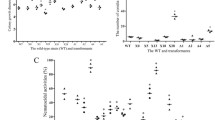Abstract
Hydrophobin cDNA (fv-hyd1), which is specifically expressed during fruiting body development, was isolated from the basidiomycete Flammulina velutipes by differential display screening. Analysis of the genomic structure of fv-hyd1 revealed an open reading frame (ORF) composed of 363 nucleotides and interrupted by three introns. The deduced amino acid sequence of FV-HYD1 showed a similarity to those of other fungal class I hydrophobins and contained eight cysteine residues highly conserved among hydrophobin proteins. The pattern of the hydropathy plot of FV-HYD1 was similar to those of class I hydrophobins. Southern blot analysis of genomic DNA showed that fv-hyd1 existed as a single copy. Northern blot analysis indicated that the fv-hyd1 transcript was not present in vegetative mycelia but markedly increased in level at the primordial stage. Moreover, the fv-hyd1 transcript was abundant even at the mature fruiting body stage. This result indicates that fv-hyd1 could encode a hydrophobin closely associated with fruiting body development.






Similar content being viewed by others
References
Ando A, Harada A, Miura K, Tamai Y (2001) A gene encoding a hydrophobin, fvh1, is specifically expressed after the induction of fruiting in the edible mushroom Flammulina velutipes. Curr Genet 39:190–197
Asgeirsdottir SA, De Vries OMH, Wessels JGH (1998) Identification of three differentially expressed hydrophobins in Pleurotus ostreatus (oyster mushroom). Microbiology 144:2961–2969
Ballance DJ (1986) Sequence important for gene expression in filamentous fungi. Yeast 2:229–236
Breathnach R, Chambon P (1981) Organization and expression of eucaryotic split genes coding for proteins. Annu Rev Biochem 50:349–383
De Groot PWJ, Schaap PJ, Sonnenberg ASM, Visser J, Van Griensven LJLD (1996) The Agaricus bisporus hypA gene encodes a hydrophobin and specifically accumulates in peel tissue of mushroom caps during fruit body development. J Mol Biol 257:1008–1018
De Groot PWJ, Roeven RTP, Van Griensven LJLDL, Visser J, Schaap PJ (1999) Different temporal and spatial expression of two hydrophobin-encoding gene of the edible mushroom Agaricus bisporus. Microbiology 145:1105–1113
Dons JJM, Springer J, De Vries SC, Wessels JGH (1984) Molecular cloning of a gene abundantly expressed during fruiting body initiation in Schizophyllum commune. J Bacteriol 157:802–808
Garber RC, Yoder OC (1983) Isolation of DNA from filamentous fungi and separation into nuclear, mitochondrial, ribosomal, and plasmid components. Anal Biochem 135:416–422
Gurr SJ, Unkles SE, Kinghorn JR (1987) The structure and organization of nuclear genes in filamentous fungi. In: Kinghorn JR (ed) Gene structure in eukaryotic microbes. IRL, Oxford, pp 93–139
Kershaw MJ, Talbot NJ (1998) Hydrophobins and repellents: proteins with fundamental roles in fungal morphogenesis. Fungal Genet Biol 23:18–33
Kues U, Liu Y (2000) Fruiting body production in basidiomycete. Appl Microbiol Biotechnol 54:141–152
Lugones LG, Wosten HAB, Wessels JGH (1998) A hydrophobin (ABH3) specifically secreted by vegetatively growing hyphae of Agaricus bisporus (common white button mushroom). Microbiology 144:2345–2353
Lugones LG, Wosten HAB, Birkenkamp KU, Sjollema KA, Zagers J, Wessels JGH (1999) Hydrophobin line air channels in fruiting bodies of Schizophyllum commune and Agaricus bisporus. Mycol Res 103:635–640
Mulder GH, Wessels JGH (1986) Molecular cloning of RNAs differentially expressed in monokaryons and dikaryons of Schizophyllum commune in relation to fruiting. Exp Mycol 10:214–227
Penas MM, Asgeirsdottir SA, Lasa I, Culianez-Macia FA, Pisabarro AG, Wessels JGH, Ramirez L (1998) Identification, characterization, and in situ detection of a fruit-body-specific hydrophobin of Pleurotus ostreatus. Appl Environ Microbiol 64:4028–4034
Schuren FHJ, Wessels JGH (1990) Two genes specifically expressed in fruiting dikaryons of Schizophyllum commune: homologies with a gene not regulated by mating-type genes. Gene 90:199–205
Van Wetter MA, Wosten HAB, Wessels JGH (2000a) SC3 and SC4 hydrophobins have distinct roles in formation of aerial structures in dikaryons of Schizophyllum commune. Mol Microbiol 36:201–210
Van Wetter MA, Wosten HAB, Sietsma JH, Wessels JGH (2000b) Hydrophobin gene expression affects hyphal wall composition in Schizophyllum commune. Fungal Genet Biol 31:99–104
Wessels JGH (1997) Hydrophobins: proteins that change the nature of the fungal surface. Adv Microbiol Physiol 38:1–45
Wessels JGH (2000) Hydrophobins, unique fungal proteins. Mycologist 14:153–159
Wosten HAB, Richter M, Willey JM (1999) Structural proteins involved in emergence of microbial aerial hyphae. Fungal Genet Biol 27:153–160
Wosten HAB, De Vocht ML (2000) Hydrophobins, the fungal coat unraveled. Biochim Biophys Acta 1469:79–86
Acknowledgements
This work was supported by a Grant-in-Aid for the 21st Century COE Program by the Ministry of Education, Culture, Sports, Science, and Technology. We are indebted to the Division of Gene Research, Research Center for Human and Environmental Sciences, Shinshu University, for providing facilities.
Author information
Authors and Affiliations
Corresponding author
Rights and permissions
About this article
Cite this article
Yamada, M., Sakuraba, S., Shibata, K. et al. Cloning and characterization of a gene coding for a hydrophobin, Fv-hyd1, specifically expressed during fruiting body development in the basidiomycete Flammulina velutipes. Appl Microbiol Biotechnol 67, 240–246 (2005). https://doi.org/10.1007/s00253-004-1776-2
Received:
Revised:
Accepted:
Published:
Issue Date:
DOI: https://doi.org/10.1007/s00253-004-1776-2




